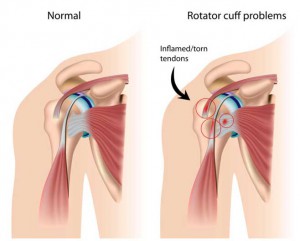Open Rotator Cuff Repair
 During Open Rotator Cuff Repair, a surgical incision is made the large muscle is moved out the way to do the surgery. Open Rotator Cuff Repair is done for large or more complex tears. The rotator cuff is a group of muscles and tendons that form a cuff over the shoulder joint. The tendons can be torn from overuse or injury. Open Rotator Cuff Repair remains the gold standard for addressing large, retracted rotator cuff tears.
During Open Rotator Cuff Repair, a surgical incision is made the large muscle is moved out the way to do the surgery. Open Rotator Cuff Repair is done for large or more complex tears. The rotator cuff is a group of muscles and tendons that form a cuff over the shoulder joint. The tendons can be torn from overuse or injury. Open Rotator Cuff Repair remains the gold standard for addressing large, retracted rotator cuff tears.
Preparation for Open Rotator Cuff Repair
Expand SectionTell your health care provider what medicines you are taking. This includes medicines, supplements, or herbs you bought without a prescription.
Pre-surgical preparations for Open Rotator Cuff Repair may include: Physical examination to include assessment of the AC joint tenderness and or pain with shoulder adduction. Obtain radiographs. Consider magnetic resonance imaging to evaluate the characteristics of the tear.
During the 2 weeks before your surgery:
You may be asked to stop taking medicines that make it harder for your blood to clot. These include aspirin, ibuprofen (Advil, Motrin), naproxen (Naprosyn, Aleve), and other medicines.
Ask your health care provider which medicines you should still take on the day of your surgery.
On the day of surgery:
- You will likely be asked not to drink or eat anything for 6 to 12 hours before the procedure.
- Take the medicines your surgeon told you to take with a small sip of water.
- Your surgeon or nurse will tell you when to arrive at the hospital. Be sure to arrive on time.
Open Rotator Cuff Repair Surgery
A traditional Open Rotator Cuff Repair surgical incision is (several centimeters long) often required if the tear is large or complex. The surgeon makes the incision over the shoulder and detaches the shoulder muscle (deltoid) to better see and gain access to the torn tendon. An open repair may be a good option if the tear is large or complex or if additional reconstruction, such as a tendon transfer, is indicated. Open Rotator Cuff Repair was the first technique used for torn rotator cuffs. Over the years, new technology and improved surgeon experience has led to less invasive procedures
After the Rotator Cuff Repair Surgical Procedure
You will be wearing a sling when you leave the hospital. Some patients also wear a shoulder immobilizer. This keeps your shoulder from moving. How long you wear the sling or immobilizer will depend on the type of surgery you had.
- Recovery can take 3 to 6 months, depending on the size of the tear and other factors. You may have to wear a sling for 4 to 6 weeks after surgery. Pain is usually managed with medicines.
- Physical therapy can help you regain the motion and strength of your shoulder. The length of therapy will depend on the repair that was done.
Risks
- Risks of anesthesia are: Allergic reactions to medications, problems breathing
- Risks rotator cuff surgery is:
- Bleeding, Infection, and Injury to a blood vessel or nerve
